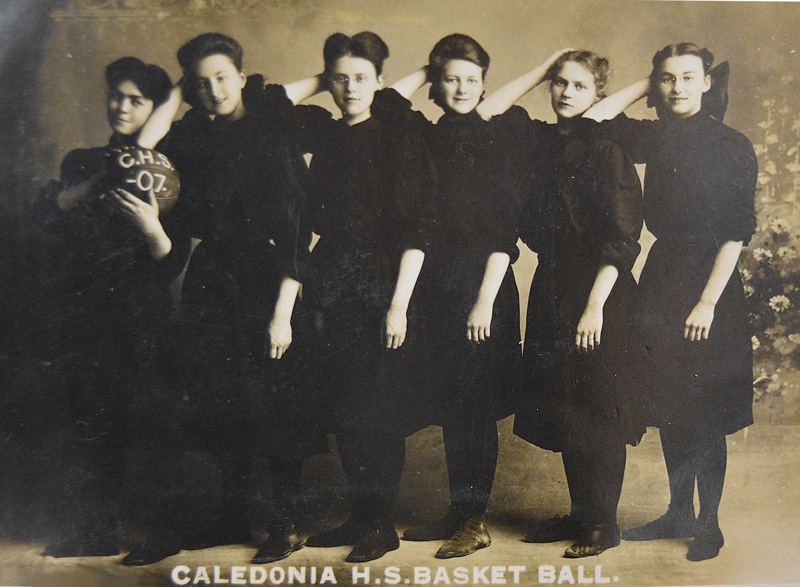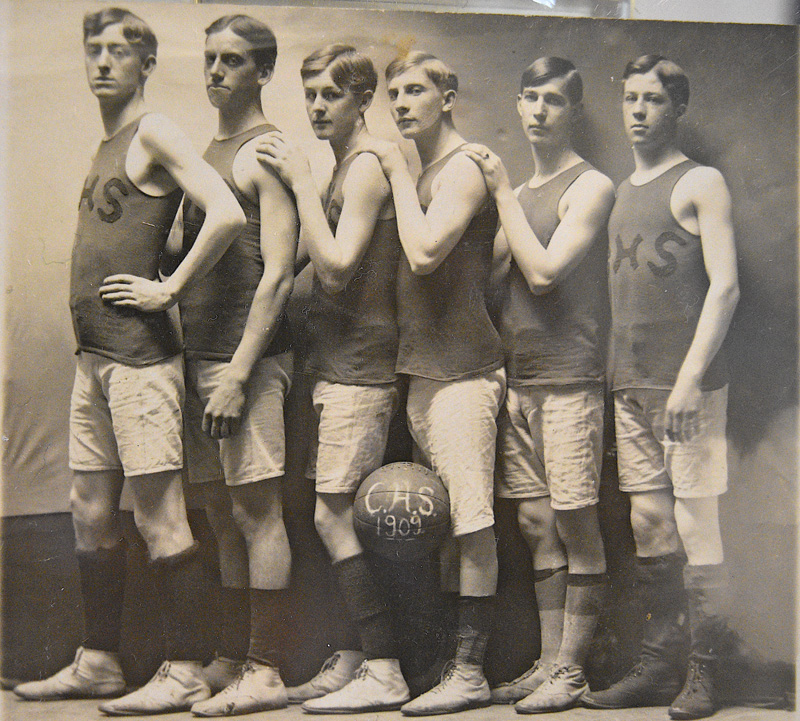Walls, a wood stove and even spectators were hazards; you might run or dribble into one – or someone. But it was too cold to play outside when high school basketball was first witnessed in Caledonia. The year was 1907; the venue was the Hundt Opera House, which built on North Badger Street, was originally intended to provide an indoor roller-skating rink. But that rolling recreation would not be as financially profitable an enterprise as expected, and the building changed ownership several times before Mr. and Mrs. Hundt made changes, including a stage, so the edifice could be rented for dancing, stage performances or other community gatherings, which turned out to include basketball.
The basketball court ran from east to west with one basket right up against the stage and the other hoop a few feet from the main entrance. The sidelines were actually the walls on the north and south side of the hall. A local carpenter constructed the backboards, and Caledonia Wagon and Iron Works made the rims. There were no nets to provide any assistance in ascertaining whether or not the ball actually passed through the rim. The playing surface received no treatment other than being mopped occasionally or whenever needed.
Space was available for spectators on the stage and in a narrow gallery across the west wall plus limited standing room at both ends of the court. Anyone standing would have been advised to be prepared for a rebound.
The building was heated by two wood-burning stoves, one at the back of the stage and the other in the northwest corner just a step away from the basketball court. Caledonia journalist Perk Steffen wrote, “During practice and play, prudent caution was required to avoid being branded by the stove’s hot metal jacket.”
Restrooms? There were none. But there were the nearby outhouses belonging to neighborhood families – Wisland, Lutz, Steenstrup and Crotty. And if waiting lines were too long, there was the more-distant backyard of Thomas Ryan at the corner of Main and Badger Streets. Just across the street from the Opera House, indoor plumbing had been installed at the home of W. D. Belden. But as Steffen expressed, “It was hardly thought proper to invade the privacy of the home without special invitation.”
In the early 1900s, basketball did draw a crowd but did not yet command the widespread respect that it would later. For some citizens, boys – even older ones – cavorting about in undergarments was not deemed commendable conduct. And the girl cagers? Despite them being “voluminously bloomered” (wearing bloomers), many commented about the poor judgement of mothers who allowed their daughters to engage in such inappropriate exhibitions.
Nevertheless, one fan who could be seen and distinctly heard at every game was Mrs. F. A Duxbury, who from her seat in the front row of the balcony, voiced her reactions, agreeably or disagreeably, to action on the floor below.
The photo of the 1907 Caledonia boys team included the coach, Superintendent J. M. Clark and only six lads: Ralph Rollins, Carl Speaker, George Wheaton, Jacob Lovett, William Flynn and Ray Evans. That first girls squad was said, many decades later, to have been the tallest local contingent ever, all of whom could reach six feet by standing on their toes. They were Erma King, Luella Seufert, Catherine Roverud, Mary Krier, Edna Solberg and Hazel Rhines.
The Hundt Opera House was completely destroyed by fire during the winter of 1909. When the Caledonia City Hall was completed in 1911, basketball games were played on the second story theatre floor. But again, floor space was limited. Backboards were on the east and west walls. Spectators were seated again on the stage and in the balcony with standing room wherever possible.
Finally, with the construction of the Municipal Auditorium in 1938, players could compete on a full-size basketball court without the hindrance of walls or a wood stove or the toes of spectators.
The first state basketball tournament for boys was held in 1913 in the Twin Cities. Caledonia did not compete in a playoff tournament until 1916. The Warriors, coached by Otto Madland, won the district playoff tournament for the first time in 1930, defeating Harmony in front of a crowd of 1,400 at Lanesboro. Advancing to the regional tournament, Caledonia fell to both Austin (26-16) and Luverne (22-20).
According to the Minnesota State High School League archives, the Warrior boys earned their first state tournament berth in 1995, the first of three consecutive state tournament appearances in 1995 and 1996 before winning a state championship in 1997. Through 2024, the boys have qualified for state 10 times.
While boys basketball and other sports continued to flourish nationwide, girls sports mostly disappeared until the federal Title IX legislation of 1972, a civil rights law that prohibited gender-based discriminartion in any school or any other education program that received funding from the federal government.
In 1972, bloomers were no longer fashionable nor surely even available when Minnesota girls were again dribbling, shooting, defending and competing in varsity sports. The first state basketball tournament for girls in Minnesota was held in 1976. Caledonia fielded its first varsity team for the 1974-75 season – a new experience for both players, parents and spectators. The roster consisted mostly of juniors and sophomores, coached by Shelly Jilek. Those groundbreaking Warrior girls finished with a 5-9 record. Dave Ellefson assumed coaching duties the next season and guided the program for eight seasons with a record of 94-61, including a conference co-championship in 1977.
Coached by Terry Mullins, the Caledonia girls claimed their first district playoff championship in 1986 before earning their first state tournament appearance in 1992. It was the first state tournament berth for any Caledonia basketball team. In 12 years at the helm, Mullins-led squads won 245 games with only 42 losses. Through the 2024 campaign, Caledonia girls have qualified for state seven times, winning state in 2009.
Sources: “Beginnings of Basketball in Caledonia in 1907,” taken from The Town Crier by Perk Steffen, reprinted with permission of Caledonia Argus; “Caledonia Boys Basketball” by Peter Kittleson and Natalie Mindrum; “Girls Basketball,” by Ken Van Den Boom, Terry Mullins, Tina Esch and Bobby Schieber, all published in Caledonia Pride 1854 – 2004




Leave a Reply